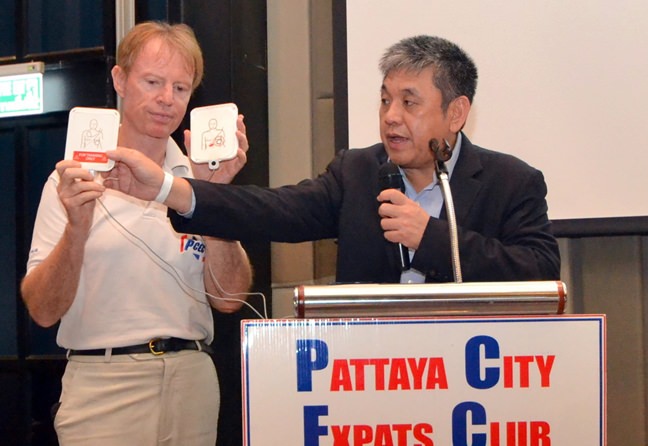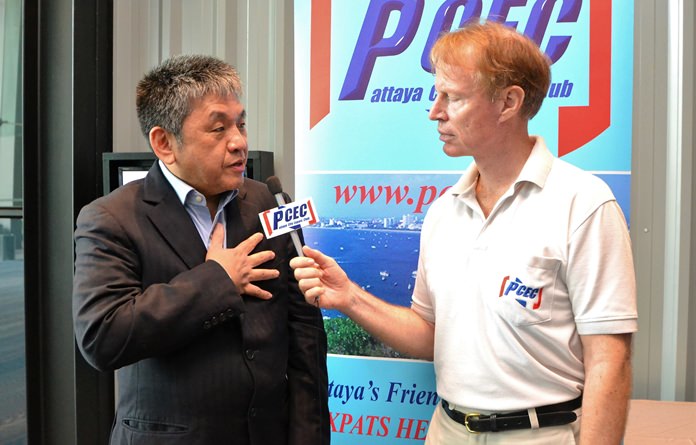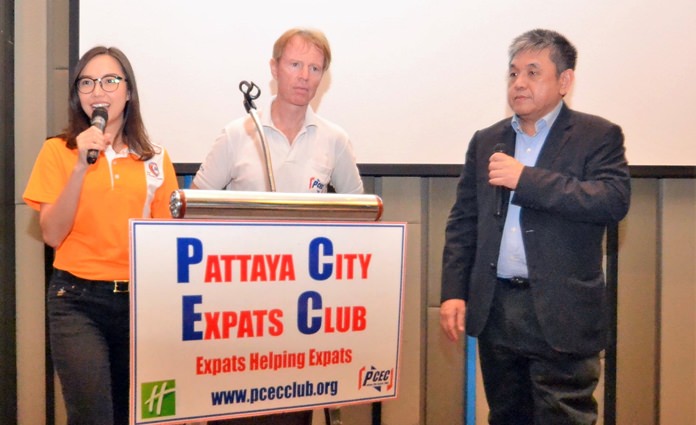
At the PCEC’s Sunday, March 18, meeting, the members and guests learned about heart attacks and how CPR and an AED could save your life by prolonging it enough to get to a hospital with angioplasty capability. The very knowledgeable Cardio-Thoracic Surgeon Dr. Sujit Banyatpiyaphod, M.D., Director of the Heart Center at Bangkok Hospital Pattaya, gave the presentation.
 Dr Sujit started by saying that Chronic Heart Disease is the number one cause of death in the USA. Heart attack can strike at any time and he stressed the importance of reducing the risk factors and to be aware of the warning signs to enable a quick response. He explained that in a Myocardial Infarction the heart muscle lacks oxygen due to a sudden blockage of blood flow. This reduced oxygen level can cause heart attack. The heart stops pumping; death can follow in a matter of minutes.
Dr Sujit started by saying that Chronic Heart Disease is the number one cause of death in the USA. Heart attack can strike at any time and he stressed the importance of reducing the risk factors and to be aware of the warning signs to enable a quick response. He explained that in a Myocardial Infarction the heart muscle lacks oxygen due to a sudden blockage of blood flow. This reduced oxygen level can cause heart attack. The heart stops pumping; death can follow in a matter of minutes.
Further, that some heart attacks are sudden and intense, but most start slowly with mild pain and discomfort. Often people affected are not sure what is wrong and therefore it is important to be aware of the warning signs and symptoms of such episodes – it could save your life!
Warning signs could include chest discomfort. Most heart attacks involve discomfort in the centre of the chest. It can feel like an uncomfortable pressure, a squeeze, fullness or pain. However, symptoms can present in other parts of the upper body too – pain or discomfort in one or both arms.
Dr. Sujit stressed that there are several things that exasperate the likelihood of heart disease. These are all risk factors and should be monitored: the number one in this list is smoking – one cigarette shortens life expectancy by 8 minutes; heavy drinking – drinking too much alcohol can raise the levels of some fats in the blood. It can also lead to high blood pressure, heart failure and an increased calorie intake; high cholesterol – elevated cholesterol levels are one of the risk factors for heart disease and stroke; plaque build-up within arteries decreases blood flow affecting the function of the cells and organs that these blood vessels supply; high blood pressure or hypertension, is a condition in which the force of blood against artery walls is too strong – over time, without treatment, high blood pressure can damage the arteries, heart, and kidneys and can lead to heart disease and stroke; diabetes – diabetics are more likely to develop heart disease and have a greater chance of a heart attack or a stroke. He mentioned that the ABC’s of prevention are: Avoid tobacco, Become more active, and Choose good nutrition.
An ST-segment elevation myocardial infarction (STEMI) is a serious form of heart attack in which a coronary artery is completely blocked and a large part of the heart muscle is unable to receive blood. This type of heart attack requires immediate, emergency revascularization which restores blood flow through the artery. This revascularization is achieved either with drugs in the form of thrombolytics (clot busters), which are given intravenously, or mechanically with angioplasty – a treatment using thin, flexible tubes called catheters to open the closed artery by use of a balloon which may also include inserting a wire mesh (stent).

Dr. Sujit said time was of the essence. He was anxious to stress the importance of rapid response to a heart attack. He reiterated that there was no cure for heart attack, however, life can be prolonged. If the heart cannot pump blood to the brain, it will be starved of oxygen and brain damage or death can occur. The heart can continue to beat without blood, but the brain cannot survive without this life giving fluid.

Cardiac arrest strikes immediately and without warning. It is a sudden loss of heart function. There is a sudden loss of responsiveness (no response to tapping on shoulders). If these signs of cardiac arrest are present, tell someone to call emergency services and if possible apply Cardio Pulmonary Resuscitation (CPR) to keep blood flow to the brain and use an Automated External Defibrillator (AED) to try to restore a normal rhythm. Dr. Sujit said that CPR can save someone’s life. It can help a person who has stopped breathing, and whose heart may have stopped beating, to stay alive. CPR should be performed immediately at about 100 compressions to the minute. CPR can double or triple the survival rate of the person. The guidelines are to use chest compressions only and not to worry about mouth to mouth resuscitation. If good chest compressions are started straight away, within 8 minutes following the attack, the person’s survival rate increases to 40%-50%.
High quality chest compressions are at a depth of 2 inches, a rate of 100 per minute, and let the chest recoil fully in between each one. And remember minimal interruption between them otherwise blood will not reach the brain. He noted that chest compressions are not intended for children and infants under 8 years of age or for victims of drowning. Any effort is better than no effort. Chest compressions will not restart the heart, so it is very important not to stop doing them. It will however, improve the response to AED shock at the hospital or when the ambulance crew arrives.

Dr. Sujit concluded by explaining how to use an Automated External Defibrillator (AED). Use of an AED can be done by almost anyone as they include voice instructions on their use. They are becoming more readily available around the world in homes, cars, shops and offices, are easy to use and can be purchased.
MC Ren Lexander then brought everyone up to date on current events. This was followed by the “Open Forum” portion of the meeting, where questions are asked and answered and comments made about expat living in Thailand. For more information on the Club and their activities, visit www.pcec.club.





